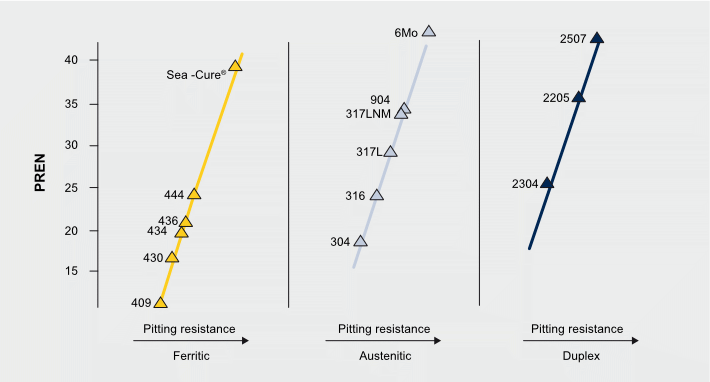Stainless grades and properties
Specifications define a couple hundred stainless steel grades, differing from one another mainly in chemical composition. Composition is a fundamental characteristic of stainless steel because it determines the alloy's corrosion resistance, microstructural phase balance, mechanical properties, and physical properties. The most widely used grades are austenitic Types 304 and 316 and ferritic Types 409 and 430.
Stainless steels are produced in accordance with government and industry standards that specify their composition and mechanical properties. Stainless steel product forms such as plate, sheet, pipe, tubing and fittings are routinely produced to meet either ASTM standards or EN specifications.
Because of the large number of stainless steels with their large variation in compositions, empirical tools have been developed to estimate the relative corrosion resistance based on a stainless steel’s composition. The corrosion resistance of stainless steel in chloride-bearing environments is largely due to its chromium, molybdenum, and nitrogen content. An empirical relationship called the Pitting Resistance Equivalent Number (PREN) has been developed to relate a stainless steel’s composition to its relative pitting resistance in chloride-bearing environments. The PREN formula for austenitic and duplex stainless steels is:
PREN = %Cr + 3.3(%Mo + 0.5%W) + 16(%N)
With ferritic stainless steels, the nitrogen content is not beneficial for corrosion resistance therefore the PREN formula for ferritic stainless steels is:
PREN = %Cr + 3.3(%Mo + 0.5%W)
These PREN relationships are typically not used to rank the resistance of martensitic and precipitation hardened stainless steels and PREN values are usually not reported for these stainless steel families.
Higher PREN values indicate greater corrosion resistance. These formulae suggests that molybdenum is 3.3 times more effective than chromium at improving pitting resistance, which is true within limits. Chromium must always be present in stainless steel to provide basic corrosion resistance. Molybdenum by itself cannot provide this basic resistance, but it significantly enhances a stainless steel's corrosion resistance, as the formula shows.
Selection of an appropriate stainless steel grade depends primarily on the corrosiveness of the application environment and the application's strength requirements. When more than one alloy meets these requirements, other factors like toughness, physical properties, fabricability, availability and cost are considerations.

Comparison of PREN values for different ferritic, austenitic and duplex stainless steels (after ArcelorMittal)

